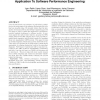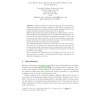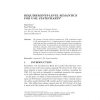532 search results - page 59 / 107 » The UML as a Formal Modeling Notation |
IFM
2007
Springer
14 years 1 months ago
2007
Springer
In this paper, we introduce a common semantic framework for developing and formally modeling use cases and task models. Use cases are the notation of choice for functional require...
JSW
2007
13 years 7 months ago
2007
— UML sequence diagrams focus on the interaction between different classes. For distributed real time transaction processing it is possible to end up with complex sequence diagra...
WOSP
2004
ACM
2004
ACM
From UML activity diagrams to Stochastic Petri nets: application to software performance engineering
14 years 1 months ago
Over the last decade, the relevance of performance evaluation in the early stages of the software development life-cycle has been steadily rising. We honestly believe that the int...
FM
1999
Springer
14 years 4 hour ago
1999
Springer
Software architecture addresses the high level specification, design and analysis of software systems. Formal models can provide essential underpinning for architectural descripti...
FMOODS
2000
13 years 9 months ago
2000
We propose a formal real-time semantics for UML statecharts aimed at the requirements level. A requirements-level model assumes perfect technology and has a considerably simpler se...



